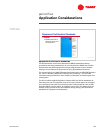
58 TRG-TRC013-EN
notes
period four
Application Considerations
Effect of Actual (Nonstandard) Conditions
Most fan performance data is published at standard air conditions, which are
basically sea level elevation and 70°F [21°C]. If the airflow requirement for a
given application is stated at nonstandard conditions, a density correction must
be made prior to selecting a fan.
The procedure for selecting a fan at actual elevations and/or temperatures is:
1) Determine the actual air density and calculate the air density ratio (density
at actual conditions divided by density at standard conditions)
2) Divide the design static pressure at actual conditions by this air density
ratio
3) Use the actual design airflow and static pressure, corrected for standard
conditions, to select the fan from the performance tables/charts and to
determine the speed (rpm) and input power requirement of the fan at
standard conditions
4) The fan speed (rpm) is the same at both standard and actual conditions
5) Multiply the input power requirement by the air density ratio to determine
the actual input power required
It is important to note that most pressure-loss charts for other system
components, such as ducts, filters, coils, etc. are also based on standard air
conditions.
Effect of Actual Conditions
1) Air Density Ratio =
2) SP
standard
=
3) Use Airflow
actual
and SP
standard
to select fan
4) RPM
standard
= RPM
actual
5) Power
actual
= Air Density Ratio × Power
standard
Density
actual
Density
standard
SP
actual
Air Density Ratio
Figure 83


















